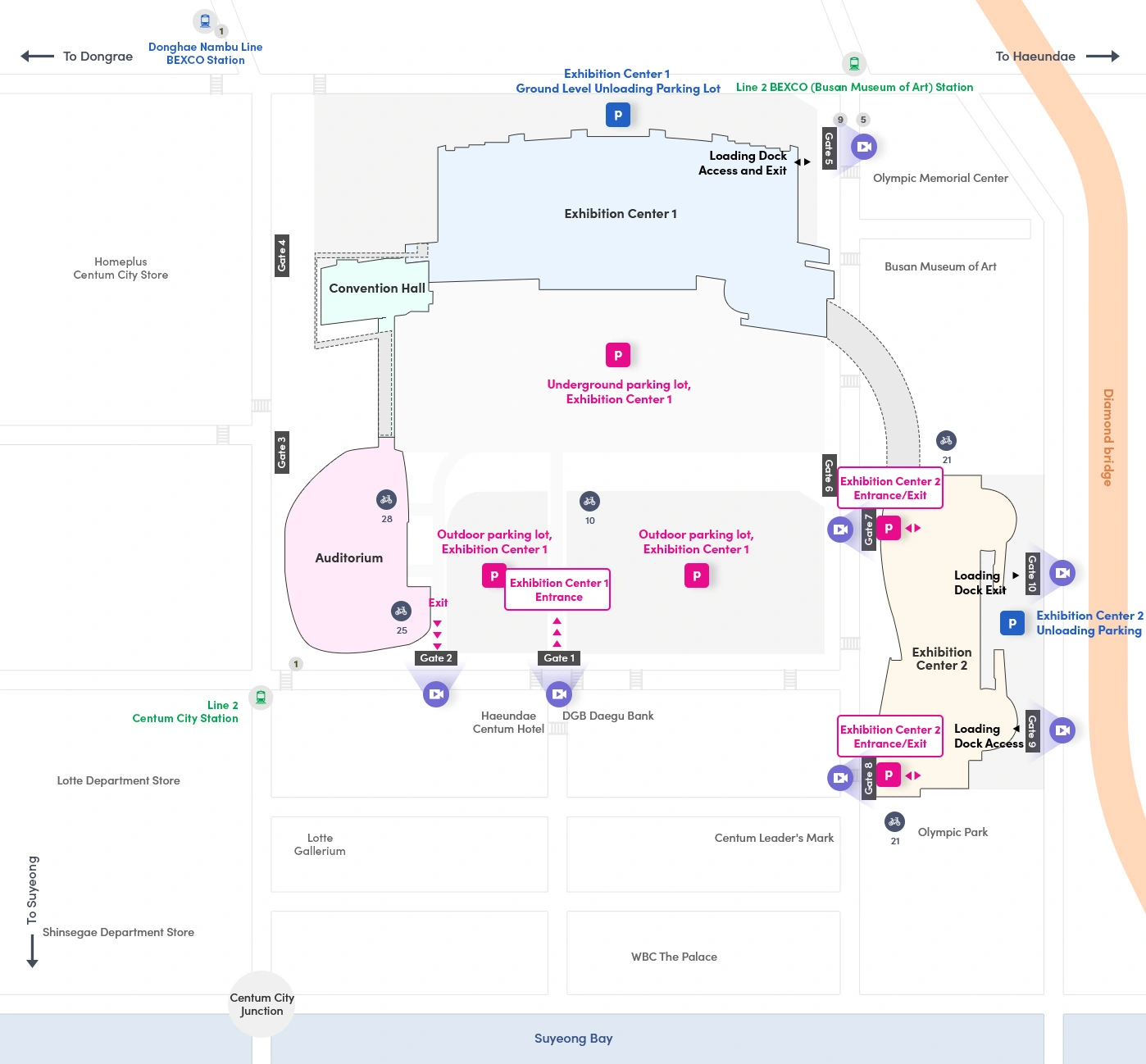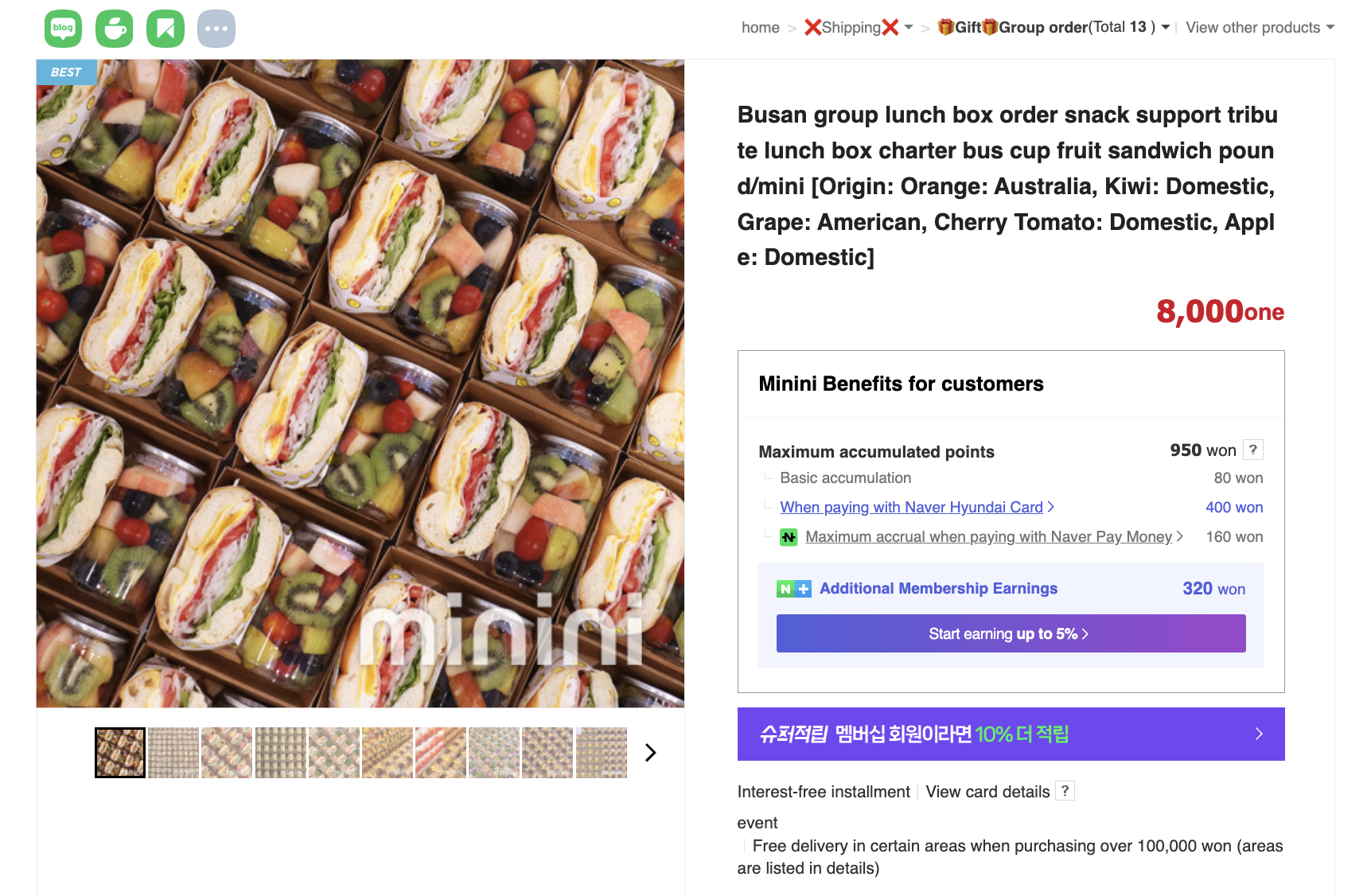
THANK YOU FOR YOUR REQUEST
Thank you very much for your interest in EIDETIC MARKETING.
We look forward to working with you.
We will contact you soon.Thanks Again.

THERE WAS A PROBLEM WITH YOUR SUBMISSION.
Have you checked all the required fields?
We want you to write your Company, Name, E-mail, Budget, Country to Execute, Website URL, Wanted Services and Project Description.Thanks.
Tag Archives: BEXCO parking
How to Get to BEXCO for G-Star Korea Exhibitors
August 9, 2024

Today, we’re diving into detailed transportation information for navigating Busan. These tips may seem small, but they can make a big difference in your trip planning for G-Star. We hope this guide is helpful for teams planning their trip to the event.
Before diving in, it might be useful to check out our general transportation and parking tips for more background.
Previous Content: Hotel Booking & Parking Tips
Now, let’s explore how to get to BEXCO or your hotel in Busan via various transportation methods, including flights, trains, buses, subways, and taxis. I hope this guide provides practical assistance to exhibitors preparing for G-Star Korea.
1. When Arriving at Incheon Airport
Route: Incheon Airport ➤ Seoul Station ➤ Busan Station
One common route is to take the airport railroad from Incheon Airport to Seoul Station, then transfer to the KTX for Busan Station. Despite Gimhae International Airport being closer, many travelers opt for this route due to better connectivity.
1-1. Incheon Airport ➤ Seoul Station (via Airport Railroad)
The quickest way from Incheon Airport to Seoul Station is by the Airport Railroad. Since Seoul Station is centrally located, taxis and buses can take longer. However, the regular Airport Railroad stops at several stations between the airport and Seoul Station, which can take time (68 minutes from Terminal 2 to Seoul Station.)
The AREX Express Train is the fastest option, running non-stop directly to Seoul Station.
- • Travel Time: 43 minutes from Terminal 1 to Seoul Station, 62 minutes from Terminal 2 to Seoul Station.
- • Fare: 11,000 KRW (approximately $8) for adults.
For more details on ticket purchasing, usage and train schedule, check out the link: AREX Site Link
Here’s a detailed guide on how to take the express train [Link]
1-2. Seoul Station ➤ Busan Station (via KTX)
Upon arriving at Seoul Station, you’ll need to transfer to the KTX for Busan. Allow at least 15 minutes to navigate the station, but it’s wise to budget around 30 minutes just in case.
- • Travel Time: 2 hours 45 minutes to 3 hours 20 minutes from Seoul to Busan by KTX.
- • Fare: 59,800 KRW (approximately $43) for adults.
KTX Reservation here [Link]

1-3. From Busan Station to BEXCO or Your Hotel
a. By Express Bus (Bus #1001, #1003 recommended ⭐️⭐️⭐️)🚌


These express buses go directly to popular destinations like Gwangalli, BEXCO, and Haeundae. If you’re not taking a taxi, this is the most recommended option for public transportation.
- • Travel Time: Approximately 30 minutes from Busan Station to BEXCO.
- • Fare: 2,100 KRW (approximately $1.50).
As mentioned in previous posts, it’s best to have a T-money transportation card ready. If not, make sure to prepare the exact fare as buses are moving away from cash payments and may not have change available.
Multiple passengers can use one T-money card, but note that all passengers must get off at the same stop when using this feature. Before tapping your T-money card, inform the driver by saying “두 사람이요.” [doo sah-rah-mee-yoh] which means 2 people or “세 사람이요. [seh sah-rah-mee-yoh] which means 3 people. The driver will then input the fare for the number of passengers. Once the driver confirms (usually with an “Okay”), you can tap your T-money card to pay the correct fare.
b. By Subway 🚊
Taking the subway is not highly recommended as it takes longer and isn’t much cheaper than the express bus. However, if you do opt for the subway, take Line 1 from Busan Station, transfer at Seomyeon Station to Line 2, and continue to Gwangalli, BEXCO, or Haeundae. Fares start at 1,600 KRW (approximately $1.10.)
In Korea, there are no paper tickets so it’s recommended to purchase a T-money card, a rechargeable smart card, since you’ll need it to tap in and out of the subway system. Group rides on a single card aren’t allowed. If you already have a T-money card, simply ensure it has a balance, tap, and board. T-money cards typically cost around 5,000 KRW (approximately $3.60.) Alternatively, you can purchase a single-use card at the subway station for about 1,350 to 1,550 KRW, depending on the travel distance. This card is valid for one trip only and allows you to travel to your destination.
c. By Taxi 🚕
If you have a lot of luggage, taking a taxi is your best option. There are plenty of taxis available at the Busan Station taxi stand, or you can use the Kakao Taxi app to call a ride.
- • Busan Station to Gwangalli: 25-40 minutes, 11,000-16,000 KRW (approximately $8 to $12).
- • Busan Station to BEXCO: 25-45 minutes, 15,000-19,000 KRW (approximately $10 to $13).
- • Busan Station to Haeundae: 45 minutes to 1 hour, 20,000-25,000 KRW (approximately $14 to $18).
Don’t be surprised by the driving style in Busan ⎯ there are a lot of macho drivers, and things can get a little rough. 😅
2. When Arriving at Gimhae International Airport
Gimhae Airport also handles international flights, so some of you may be arriving directly here.
a. Express Bus 🚌
The Express Bus is a convenient option for getting to Busan Station or other major areas in Busan. [Link]
- • Interval: Every 1 hour
- • Travel Time: Approximately 1 hour to 2 hours.
- • Fare: 2,100 KRW with T-money card, 2,200 KRW in cash
- • Baggage Restrictions: No items over 50X40X20(cm) allowed, 20 inch carry-on suitcases are permitted.
b. By Subway 🚊
From Gimhae International Airport, take the Busan-Gimhae Light Rail Transit (LRT) to Sasang Station. Transfer to Line 2 (Green Line) at Sasang Station and head towards Jangsan. Get off at Centum City Station. BEXCO is a short walk from there.
- • Travel Time: Approximately 1 hour.
- • Fare: 1,800 KRW (approximately $1.30)
c. By Taxi 🚕
Taxis are available outside Gimhae International Airport. Here are the typical travel times and fares:
- • Gimhae Airport to Gwangalli: 40 minutes to 1 hour, 20,000~32,000 KRW (approximately $15 to $24.)
- • Gimhae Airport to BEXCO: 40-50 minutes, 22,000~32,000 KRW (approximately $16 to $24.)
- • Gimhae Airport to Haeundae: 50 minutes to 1 hour 10 minutes, 27,000~36,000 KRW (approximately $20 to $27.)
For more details on using taxis in Busan, refer to section 1-3 c.

3. When Renting a Car
Renting a car can offer flexibility and convenience. Here’s how to get to BEXCO if you’re driving:
If you’re driving from Busan Station, head east on Jungang-daero, follow signs for Centum City, and take the exit toward Centum City. Follow the signs to BEXCO. The travel time is approximately 30 minutes, depending on traffic.
If you’re driving from Gimhae International Airport, take the airport road to the expressway, head east towards Busan, and follow signs for Centum City. Take the exit for Centum City and follow the signs to BEXCO. The travel time is approximately 40 minutes, depending on traffic.

BEXCO has ample parking spaces. Follow the signs to the parking area upon arrival. Parking fees vary by duration, typically around 2,400KRW per hour (approximately $1.85.)

❗️Caution: While renting a car in Busan is an option, it’s not highly recommended. If you’ve ever taken a taxi in Busan, you might have noticed that the drivers can be a bit aggressive. Merging into lanes can be challenging, and there are certain unspoken rules that seem to apply only to local drivers. The traffic can look chaotic, but it operates with an underlying order that may be difficult for outsiders to navigate. Unless you have nerves of steel, it’s better to skip the rental and rely on taxis instead. Taxi fares are affordable, and you’ll likely have a smoother and more comfortable ride. 👍
This updated content includes the detailed transportation methods for getting to BEXCO, covering all the options from Incheon Airport, Gimhae International Airport, and by rental car. Let me know if you need any further adjustments!
Explore more of our G-Star content on our website!
G-Star Korea Introduction [Link]
G-Star Korea Booth Design & Operation Tips [Link]
Essential Tips for G-Star Exhibitors: Hotel Booking, Parking & Transportation [Link]
Essential Tips for G-Star Exhibitors: Hotel Booking, Parking & Transportation
August 2, 2024

Preparing for G-Star Korea can be a daunting task, especially for first-time exhibitors. Here’s a comprehensive guide with essential tips to ensure a smooth and successful experience at Korea’s largest gaming expo, held annually at BEXCO in Busan.
Hotel and Accommodation Tips
- • Proximity to BEXCO: The area with the most accommodations is Haeundae, which is also a popular tourist destination. Staying in Haeundae is convenient for international visitors due to its numerous amenities and attractions.
- • Hotel Price: Look for hotels that fit your budget. On average, hotel prices in the Haeundae area range from $60 to $200 per night, depending on the level of comfort and amenities offered. Comparing options can help you find the best value.
- • Early Booking: Good accommodations typically get fully booked by July, so it’s essential to book early. Make your reservations as soon as possible to secure a place to stay during the event.
Parking Tips
Finding convenient parking at BEXCO during G-Star Korea can be challenging due to the high volume of attendees. Here are some essential parking tips to make your experience smoother.
Arrive Early
To secure a parking spot close to the entrance, aim to arrive before 8:00 AM, as parking spaces are more readily available at that time. If you arrive later, try to be there by 8:30 AM at the latest to ensure a comfortable parking experience without the stress of searching for a spot.
BEXCO Parking fees
| Item | General parking | Monthly parking | ||
|---|---|---|---|---|
| For each 10 minutes | Day parking (24 hours) | |||
| Small |
Passenger vehicles Vans (less than 25 seats) |
400 KRW | 15,000 KRW | 130,000 KRW |
| Large | Vans (25 seats or more) Trucks (2.5t or more) |
800 KRW | 30,000 KRW | – |
Transportation Tips
1. Taxi Apps
In Korea, unlike in the U.S. or Europe, there is no Uber service available. Instead while in Busan, it’s better to use the Dongbaek Taxi app, it does require a Korean phone number to sign up. In general, throughout Korea, Kakao Taxi is the most popular taxi app. It also allows registration with a foreign phone number which may make it ideal if you are a visitor. To ensure you have a taxi available when needed, it’s recommended to book your taxi a day in advance, as getting a taxi on the event day can be challenging.
Download Dongbaek Taxi App: Appstore / Google Play
2. Public Transportation
In Korea, public transportation requires a rechargeable transportation card. Unlike Japan or other countries, paper tickets are not used for subways. You need to either get a single-use transportation card or recharge a multi-use card.
Koreans typically use their check or credit cards issued in Korea, which come with postpaid transportation card functions that can be used nationwide. However, for foreigners without a Korean card, using a T-money card is essential.
- – Single-use Transportation Card: Available at subway gates, cash only.
(50,000 KRW notes might not be accepted, so prepare 10,000 KRW notes.)
- – T-money Multi-use Transportation Card: Available at airports or convenience stores. (The first purchase must be in cash.)
- – Korea Travel Card: This is a transportation card exclusively for foreigners. Sign up in advance to apply for the card, then pick it up at Incheon Airport. Once you register the card with the mobile app, you can use it for public transportation.
Catering and Lunch Orders
As an exhibitor at G-Star Korea, you likely won’t have the luxury of stepping out for lunch. Based on the experience of our accounting manager, who has been ordering lunch at G-Star for years, using a lunch box (dosirak or sandwich) service is the best option. Here’s a detailed guide to ordering at BEXCO.
1. Dosirak Services
These lunch box services are highly recommended. Contact a dosirak provider in advance and finalize the order quantity by the afternoon of the previous day. This method ensures that your meals are delivered on time each day during the exhibition setup and event days, providing a hassle-free and reliable solution.
2. Delivery Apps
For smaller orders, you can easily use the Baedal Minjok (Baemin) app to order dosirak. However, it’s advisable to place your orders early, as delivery times can be delayed due to high demand.

3. Dinner options
During the exhibition period, having dinner near BEXCO or at your accommodation is your best bet since you probably don’t want to have dosirak for every meal. Here are some tips for dinner.

Reservations for Large Groups
If you have a large group, it’s advisable to make reservations in advance. Many restaurants offer reservation services through the Naver Map app.
Naver Map App
In Korea, Naver Map is more commonly used than Google Maps. You can easily sign up for Naver as a foreigner and use the app to find and reserve tables at nearby restaurants. This ensures a smooth dining experience without long waits, especially for larger groups.
Digital Tools
Mobile Connectivity
In Korea, international calls are often perceived as spam, leading to blocked calls. Therefore, it is recommended to use a Korean SIM or eSIM with a local number rather than relying on roaming. Prices vary depending on whether you need a phone number or just data, so check the following sites for options.
- • Korea SIM Card Options: Depending on your needs, you can get SIM cards that include both data and a phone number, or data-only options, at mobile carrier stores or convenience stores.
- • Korea eSIM Options: For those who prefer eSIM, similar plans are available. Ensure your device supports eSIM and check the provider’s details for registration.
Weather and Clothing
Temperature Consideration
November in Korea can be very cold and chilly. Busan, being a coastal city, experiences strong winds, making a puffer jacket an essential. Many Koreans will likely be wearing long padded overcoats. So if you are in charge of an outdoor booth, make sure to bring a long padded coat and heat packs. Heat packs can be easily found at convenience stores for about 1-2 dollars.
Rain or Snow Preparedness
If it rains or snows, you must be prepared to manage the risks. Last year, during the G-Star event, it rained heavily. Unfortunately, the construction company did not properly finish the woodwork on the outdoor booth’s roof, leading to leaks. Although we had pallets and plastic tarps ready, we realized the need to move all the souvenirs to the hotel as the heavy rain began. Korean weather can be unpredictable, so it’s crucial to always be prepared for such scenarios. It’s advisable to have awning tents, pallets for floor moisture prevention, and waterproof tarps on hand.














